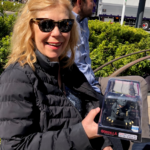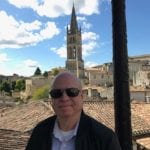Jordan, the Land of Star Wars’ Rise of Skywalker: 1
Having just arrived in Amman, Jordan’s capital, at 2 a.m. from my international flight, I was feeling a little groggy but also excited to begin an adventure that would no doubt change my life. I was immediately impressed by the way our guide was able to facilitate getting our Jordan visas at the airport without us having to wait in a long line of tired travelers. The guide spoke perfect English and was very gracious.
In the morning, our guide, Moawia, was promptly waiting for us in the lobby of our Fairmont hotel. His smiling face made me feel like I had known him for years. Heading away from our hotel, I noticed that the buildings of the city were all made of white limestone, which made it very picturesque. Amman is a modern city with a deep history. As we drove through downtown, there were many busy markets and businesses mixed in with Roman ruins, including the Roman Theater, built in AD 170. This theater is still used today as a place to sit and relax.
Our first stop was the Citadel, located in the heart of Amman. This complex was built in AD 750 and includes the ruins of the Temple of Hercules along with a Byzantine basilica, audience hall, and the ruins of the Umayyad Palace. Walking through the area gave me great views of the city. Amman is definitely worth spending a couple of nights because it has so much to offer. There are many museums, including the Archaeological Museum, featuring items over 8,000 years old. Tourists are allowed to visit the King Abdullah Mosque, dedicated by the late King Hussein to honor his grandfather. Built in 1990, this beautiful blue-domed mosque is a major landmark and can hold over 7,000 worshippers.
Within one hour’s drive was Mount Nebo. As mentioned in the Hebrew Bible, this place is where Moses first looked across the valley to the Promised Land before he died. I felt a chill as I gazed across the valley from 3,300 feet, able to see Jerusalem and the Dead Sea off in the distance. This area has remained relatively unchanged since the days of Moses. Small groups of pilgrims gathered to honor Moses and to enter the Memorial Church of Moses, constructed over earlier sanctuaries. There were beautiful mosaics inside the church dating back to AD 531. As we left Mt. Nebo, we stopped at Nebo’s Pearl, a trade school for handicapped artisans. Here, we were able to watch them make and display the beautiful mosaics, most of which were made the traditional way.
Mosaics here are important records depicting ancient life and maps of the Holy Land. Our guide, Moawia, told us the next stop would be to the ancient city of Madaba, known as the mosaic capital. It was here that a group of Christians uncovered the oldest mosaic map of the Holy Land dating back to the 6th century, now on display at St. George’s Church located in the center of town. There were other important mosaic sights throughout the village as well as local entertainment, traditional food, and local crafts. After visiting the church, we made our way through the narrow streets to have lunch at the Haret Jdoudna Restaurant. It was here, as we sat in the courtyard among the ficus trees, that I first tried the refreshing mint lemonade, a staple throughout the rest of my trip. The restaurant served delicious traditional Jordanian food consisting of hummus, fresh vegetables, lamb, chicken, and rice to name a few items. As I sat relaxing over lunch, I felt a bit overwhelmed from the sites we visited this morning. It seemed like every time I turned my head I was having a “wow” moment.
Next on my trip, I saw Petra! Talk about a “wow” moment! Stay tuned for part two of my blog in Jordan where I talk more about Petra. Contact TravelStore to see Jordan today!
Related Entries
A Memorable Trip to Guatemala and Belize
Memorable Travel Group creates a perfect display of culture and adventure in an exciting and profound adventure, combining Guatemala and Belize in one trip.
A Summer Sojourn in Bulgaria and Malta
My recent trip to Bulgaria and Malta was the result of my ongoing desire to sample new countries each year. They were close enough that I could do both,...
Jordan, the Land of Star Wars’ Rise of Skywalker: 2
It had been a full day already by this point during my Jordan trip, but it was now time to...



